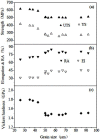New Developments of Ti-Based Alloys for Biomedical Applications
- PMID: 28788539
- PMCID: PMC5453259
- DOI: 10.3390/ma7031709
New Developments of Ti-Based Alloys for Biomedical Applications
Abstract
Ti-based alloys are finding ever-increasing applications in biomaterials due to their excellent mechanical, physical and biological performance. Nowdays, low modulus β-type Ti-based alloys are still being developed. Meanwhile, porous Ti-based alloys are being developed as an alternative orthopedic implant material, as they can provide good biological fixation through bone tissue ingrowth into the porous network. This paper focuses on recent developments of biomedical Ti-based alloys. It can be divided into four main sections. The first section focuses on the fundamental requirements titanium biomaterial should fulfill and its market and application prospects. This section is followed by discussing basic phases, alloying elements and mechanical properties of low modulus β-type Ti-based alloys. Thermal treatment, grain size, texture and properties in Ti-based alloys and their limitations are dicussed in the third section. Finally, the fourth section reviews the influence of microstructural configurations on mechanical properties of porous Ti-based alloys and all known methods for fabricating porous Ti-based alloys. This section also reviews prospects and challenges of porous Ti-based alloys, emphasizing their current status, future opportunities and obstacles for expanded applications. Overall, efforts have been made to reveal the latest scenario of bulk and porous Ti-based materials for biomedical applications.
Keywords: mechanical properties; microstructure; porous Ti-based alloys; β-type Ti-based alloys.
Conflict of interest statement
The authors declare no conflict of interest.
Figures






































References
-
- Park J.B. The Biomedical Engineering Handbook. Vol. 1. CRC Press; Boca Raton, FL, USA: 2000. Biomaterials: Introduction; pp. IV1–IV8.
-
- Temenoff J.S., Mikos A.G. Biomaterials: The Intersection of Biology and Materials Science. Pearson/Prentice Hall; Upper Saddle River, NJ, USA: 2008. pp. 235–258.
-
- Hanawa T. Recent development of new alloys for biomedical use. Mater. Sci. Forum. 2006;512:243–248.
-
- Lütjering G., Williams J.C. Titanium. 2nd ed. Springer; Berlin, Germany: 2003. pp. 20–22.
-
- Long M., Rack H.J. Titanium alloys in total joint replacement—A materials science perspective. Biomaterials. 1998;19:1621–1639. - PubMed
Publication types
LinkOut - more resources
Full Text Sources
Other Literature Sources

